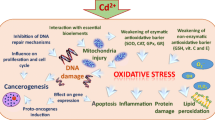Abstract
Environmental exposure to cadmium (Cd) gives rise to renal tubular dysfunction at low cumulative doses of Cd. A possible role of Cd in influencing the occurrence of diseases, e.g., bone, reproductive and cancer in the general population groups environmentally exposed to Cd has been reported from Japan, Belgium, Sweden and China. Authorities have to pay attention to this fact and to act in order to prevent serious outcomes and personal suffering in the population groups at risk. A general approach in setting recommended health based limits and to regulate the occurrence of a substance existing in food stuff is to keep low levels –better to be on the safer side than on the risk side. In the case of cadmium it should be most clear that since cadmium has a very long biological half-life of 20 years in humans, increased cadmium exposure due to human activities can never be accepted. In cases where cadmium exposure can not be avoided the approach should be to limit and decrease exposure. Presently FAO/WHO Expert Committee on Food Additives and Food has a PTWI (provisional tolerable weekly intake) value for adult persons of 7 μg/kg body weight for Cd (WHO 2003) a value corresponding to 1 μg/kg body weight for each day of a week. For children and pregnant or lactating women daily intakes should not exceed 1 μg/kg body weight.
Similar content being viewed by others
References
Agency for Toxic Substances and Disease Registry (ATSDR). 1993 Toxicological profile for cadmium. Atlanta: U.S. Department of Health and Human Services, Public Health Service.
AFS 2000 Statute Book of the Swedish National Board of Occupa-tional Safety and Health, Occupational Exposure Limit Values and Measures against Air Contaminants, Swedish Work Envir-onment Authority, Solna, Sweden. http://www.av.se/english/legislation/afs/eng0003.pdf.
AFS 2007 Arbetarskyddsstyrelsens Författningssamling,Medicinsk kontroll vid kadmium arbete, Statute Book of the Swedish Na-tional Board of Occupational Safety and Health Swedish Work Environment Authority, Solna, Sweden (in Swedish).
JECFA 2003 Safety evaluation of certain food additives and contam-inants. WHO food Additives Series, in press, Summary available at: http://www.who.int/pcs/jecfa/Summary61.pdf.
IARC 1993 Monograph Beryllium, Cadmium, Mercury and Expos-ures in the Glass manufacturing Industry volume 58, Interna-tional Agency for Research on Cancer Lyon, France; 119–237.
Nordberg M, Nordberg GF. 2000 Toxicological Aspects of Metallo-thionein. Cell Mol Biol 46, 451–463.
Nordberg M, Nordberg GF. 2002 Cadmium. In Sarkar B, ed. Heavy metals in the Environment. New York: Marcel Dekker Inc.; 231–270.
WHO 1992 Cadmium Environmental Health Criteria Document 134, International Programme on Chemical Safety, World Health Organization, Geneva.
WHO 1984 Guidelines for drinking water-quality: Health cri-teria and other supporting information. Geneva: World Health Organization; vol. 2, 84–90.
WHO 1993 Guidelines for drinking-water quality, second edition,Health Criteria and other Supporting Information. Geneva: World Health Organization; vol. 2. http://europa.eu.int/eur-lex/pri/en/oj/dat/2001/l077/l_07720010316en00140021.pdf
Author information
Authors and Affiliations
Rights and permissions
About this article
Cite this article
Nordberg, M. Environmental exposure and preventive measures in Sweden and EU* . Biometals 17, 589–592 (2004). https://doi.org/10.1023/B:BIOM.0000045743.55410.45
Issue Date:
DOI: https://doi.org/10.1023/B:BIOM.0000045743.55410.45




